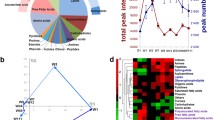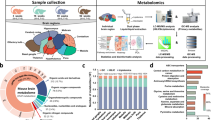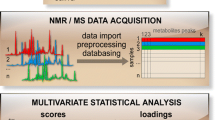Abstract
The vesicular monoamine transporter 2 (VMAT2) sequesters monoamines into synaptic vesicles in preparation for neurotransmission. Samples of cerebellum, cortex, hippocampus, substantia nigra and striatum from VMAT2-deficient mice were compared to age-matched control mice. Multivariate statistical analyses of 1H NMR spectral profiles separated VMAT2-deficient mice from controls for all five brain regions. Although the data show that metabolic alterations are region- and age-specific, in general, analyses indicated decreases in the concentrations of taurine and creatine/phosphocreatine and increases in glutamate and N-acetyl aspartate in VMAT2-deficient mouse brain tissues. This study demonstrates the efficacy of metabolomics as a functional genomics phenotyping tool for mouse models of neurological disorders, and indicates that mild reductions in the expression of VMAT2 affect normal brain metabolism.



Similar content being viewed by others
References
de Rijk MC, Breteler MM, Graveland GA et al (1995) Prevalence of Parkinson’s disease in the elderly: the Rotterdam study. Neurology 45(12):2143–2146
Cohen G (1983) The pathobiology of Parkinson’s disease: biochemical aspects of dopamine neuron senescence. J Neural Transm Suppl 19:89–103
Liu Y, Peter D, Roghani A et al (1992) A cDNA that suppresses MPP+ toxicity encodes a vesicular amine transporter. Cell 70(4):539–551
Mooslehner KA, Chan PM, Xu W et al (2001) Mice with very low expression of the vesicular monoamine transporter 2 gene survive into adulthood: potential mouse model for parkinsonism. Mol Cell Biol 21(16):5321–5331
Colebrooke RE, Humby T, Lynch PJ et al (2006) Age-related decline in striatal dopamine content and motor performance occurs in the absence of nigral cell loss in a genetic mouse model of Parkinson’s disease. Eur J Neurosci 24(9):2622–2630
Glatt CE, Wahner AD, White DJ et al (2006) Gain-of-function haplotypes in the vesicular monoamine transporter promoter are protective for Parkinson disease in women. Hum Mol Genet 15(2):299–305
Takahashi N, Miner LL, Sora I et al (1997) VMAT2 knockout mice: heterozygotes display reduced amphetamine-conditioned reward, enhanced amphetamine locomotion, and enhanced MPTP toxicity. Proc Natl Acad Sci USA 94(18):9938–9943
Uhl GR, Li S, Takahashi N et al (2000) The VMAT2 gene in mice and humans: amphetamine responses, locomotion, cardiac arrhythmias, aging, and vulnerability to dopaminergic toxins. FASEB J 14(15):2459–2465
Fiehn O (2002) Metabolomics—the link between genotypes and phenotypes. Plant Mol Biol 48(1–2):155–171
Griffin JL (2004) Metabolic profiles to define the genome: can we hear the phenotypes? Philos Trans R Soc Lond B Biol Sci 359(1446):857–871
Griffin JL (2006) The Cinderella story of metabolic profiling: does metabolomics get to go to the functional genomics ball? Philos Trans R Soc Lond B Biol Sci 361(1465):147–161
Le Belle JE, Harris NG, Williams SR et al (2002) A comparison of cell and tissue extraction techniques using high-resolution 1H-NMR spectroscopy. NMR Biomed 15(1):37–44
Macura S, Huang Y (1981) Two-dimensional chemical exchange and cross-relaxation spectroscopy of coupled nuclear spins. J Magn Reson 43(2):259–281
Govindaraju V, Young K, Maudsley AA (2000) Proton NMR chemical shifts and coupling constants for brain metabolites. NMR Biomed 13(3):129–153
Lindon JC, Nicholson JK, Everett JR (1999) NMR spectroscopy of biofluids. Annual reports on NMR spectroscopy, vol 38. pp 1–88
Jackson JE (1991) A user’s guide to principal components. Wiley, New York
Wold S, Albano C, Dunn WJ et al (1984) Multivariate data analysis in chemistry. In: Kowalski BR (ed) Chemometrics: mathematics and statistics in chemistry. D. Reidel Publishing Company, Holland
Höskuldsson A (1996) Prediction methods in science and technology. Thor Publishing, Copenhagen
Eriksson L, Johansson E, Kettaneh-Wold N et al (1999) Introduction to multi- and megavariate data analysis using projection methods (PCA and PLS). Umetrics, Umea
Wang YM, Gainetdinov RR, Fumagalli F et al (1997) Knockout of the vesicular monoamine transporter 2 gene results in neonatal death and supersensitivity to cocaine and amphetamine. Neuron 19(6):1285–1296
Miller GW, Erickson JD, Perez JT et al (1999) Immunochemical analysis of vesicular monoamine transporter (VMAT2) protein in Parkinson’s disease. Exp Neurol 156(1):138–148
Bhakoo KK, Pearce D (2000) In vitro expression of N-acetyl aspartate by oligodendrocytes: implications for proton magnetic resonance spectroscopy signal in vivo. J Neurochem 74(1):254–262
Ellis CM, Lemmens G, Williams SC et al (1997) Changes in putamen N-acetylaspartate and choline ratios in untreated and levodopa-treated Parkinson’s disease: a proton magnetic resonance spectroscopy study. Neurology 49(2):438–444
Holshouser BA, Komu M, Moller HE et al (1995) Localized proton NMR spectroscopy in the striatum of patients with idiopathic Parkinson’s disease: a multicenter pilot study. Magn Reson Med 33(5):589–594
Dunlop DS, Mc Hale DM, Lajtha A (1992) Decreased brain N-acetylaspartate in Huntington’s disease. Brain Res 580(1–2):44–48
Klunk WE, Panchalingam K, Moossy J et al (1992) N-acetyl-l-aspartate and other amino acid metabolites in Alzheimer’s disease brain: a preliminary proton nuclear magnetic resonance study. Neurology 42(8):1578–1585
Meyerhoff DJ, MacKay S, Bachman L et al (1993) Reduced brain N-acetylaspartate suggests neuronal loss in cognitively impaired human immunodeficiency virus-seropositive individuals: in vivo 1H magnetic resonance spectroscopic imaging. Neurology 43(3 Pt 1):509–515
Pears MR, Cooper JD, Mitchison HM et al (2005) High resolution 1H NMR-based metabolomics indicates a neurotransmitter cycling deficit in cerebral tissue from a mouse model of Batten disease. J Biol Chem 280(52):42508–42514
Huxtable RJ (1989) Taurine in the central nervous system and the mammalian actions of taurine. Prog Neurobiol 32(6):471–533
Sturman JA (1993) Taurine in development. Physiol Rev 73(1):119–147
Dawson R Jr, Pelleymounter MA, Cullen MJ et al (1999) An age-related decline in striatal taurine is correlated with a loss of dopaminergic markers. Brain Res Bull 48(3):319–324
Benedetti MS, Russo A, Marrari P et al (1991) Effects of ageing on the content in sulfur-containing amino acids in rat brain. J Neural Transm Gen Sect 86(3):191–203
Wallace DR, Dawson R Jr (1990) Effect of age and monosodium-l-glutamate (MSG) treatment on neurotransmitter content in brain regions from male Fischer-344 rats. Neurochem Res 15(9):889–898
Brownell AL, Jenkins BG, Elmaleh DR et al (1998) Combined PET/MRS brain studies show dynamic and long-term physiological changes in a primate model of Parkinson disease. Nat Med 4(11):1308–1312
Podell M, Hadjiconstantinou M, Smith MA et al (2003) Proton magnetic resonance imaging and spectroscopy identify metabolic changes in the striatum in the MPTP feline model of parkinsonism. Exp Neurol 179(2):159–166
Bothwell JH, Rae C, Dixon RM et al (2001) Hypo-osmotic swelling-activated release of organic osmolytes in brain slices: implications for brain oedema in vivo. J Neurochem 77(6):1632–1640
Ross B, Bluml S (2001) Magnetic resonance spectroscopy of the human brain. Anat Rec 265(2):54–84
Bluml S, Zuckerman E, Tan J et al (1998) Proton-decoupled 31P magnetic resonance spectroscopy reveals osmotic and metabolic disturbances in human hepatic encephalopathy. J Neurochem 71(4):1564–1576
Brand A, Richter-Landsberg C, Leibfritz D (1993) Multinuclear NMR studies on the energy metabolism of glial and neuronal cells. Dev Neurosci 15(3–5):289–298
Isaacks RE, Bender AS, Kim CY et al (1994) Osmotic regulation of myo-inositol uptake in primary astrocyte cultures. Neurochem Res 19(3):331–338
Saraf-Lavi E, Bowen BC, Pattany PM et al (2003) Proton MR spectroscopy of gliomatosis cerebri: case report of elevated myoinositol with normal choline levels. AJNR Am J Neuroradiol 24(5):946–951
Acknowledgements
This work was supported by the NIH grant R21 DK070288-01, USA (RMS), The Royal Society, UK (a University Research Fellowship to JLG), the UK Parkinson’s Disease Society (Grant No 4039) and the BBSRC (PCE and PJL). REC was supported by an MRC case studentship with Sanofi-Aventis.
Author information
Authors and Affiliations
Corresponding author
Additional information
Special issue article in honor of Dr. Frode Fonnum.
Rights and permissions
About this article
Cite this article
Salek, R.M., Colebrooke, R.E., Macintosh, R. et al. A Metabolomic Study of Brain Tissues from Aged Mice with Low Expression of the Vesicular Monoamine Transporter 2 (VMAT2) Gene. Neurochem Res 33, 292–300 (2008). https://doi.org/10.1007/s11064-007-9542-3
Received:
Accepted:
Published:
Issue Date:
DOI: https://doi.org/10.1007/s11064-007-9542-3




